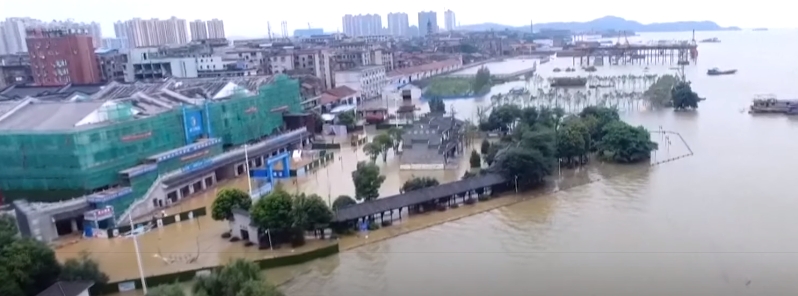One of the worst rainfall seasons on record hits China, massive floods affecting nearly 38 million people

Severe floods affecting wide swaths of China since June 2020 have left at least 141 people dead or missing and almost 38 million affected in 27 provinces, officials reported on Monday, July 13, 2020. Up to 433 rivers have risen to dangerous levels, with 33 of them crossing historical highs. This is one of the worst rainfall seasons on record, resulting in direct economic losses of more than 61 billion yuan ($8.7 billion USD).
Average precipitation in the Yangtze River over the past month and a half has reached the highest level since 1961 and water in 433 rivers has risen above flood alert levels, with 33 above historical highs.
Rainfall is now expected to move northward and the Huai River and other rivers in the north are expected to experience large-scale floods in certain areas, vice-minister of water resource, Ye Jianchun, said Monday, July 13.
"China is about to enter a critical period of flood prevention and control in late July and early August," Ye Jianchun said.
The worsening flood situation prompted China's State Flood Control and Drought Relief Headquarters to upgrade the emergency response for flood control from Level 3 to Level 2 on July 12 as incessant rains continued to cause havoc across wide swaths of the country.
In Hubei Province, more than 9 million people have been affected, at least 14 people have been killed and five others missing. Eight of the victims were due to a landslide in Huangmei County. Yangxin County in Huangshi City has now had five bouts of heavy rain since the start of the rainy season, with a total of 714 mm (28 inches) of rain between June 8 to July 10– this is almost twice the amount expected for this time of the year.
In Anhui Province, local authorities have launched Level 2 emergency response– the second-highest for flood prevention. As of Sunday noon, more than 2.15 million have been affected and four people lost their lives. Approximately 3 200 people have been evacuated in 88 temporary relocation centers.


E China’s Jiangxi province upgraded the emergency response for flood control from Level II to Level I, starting from 10 a.m. on Saturday. As of Friday, over 3.68 million residents in Jiangxi had been affected by the floods. pic.twitter.com/IDLoGP2ZMc
— People's Daily, China (@PDChina) July 11, 2020
433 rivers in China have exceeded warning levels since early June, with 33 of them rising to historical highs, the Ministry of Water Resources said on Monday. Floods have affected 37.89 million people in 27 provinces, autonomous regions and municipalities. pic.twitter.com/1xwIG3Duh8
— People's Daily, China (@PDChina) July 13, 2020
Around 5.2 million people have been affected in Jiangxi Province as of Monday. 432 000 have been evacuated and 154 000 are in urgent need of assistance. About 4.56 million ha (11.27 million acres) of crops were ravaged and nearly 1 000 houses destroyed. Flooding has caused damage costing approximately 929 million dollars.
Authorities have upgraded its emergency response for flood control, from second to the top level as of Saturday, July 11. The Ministry of Water Resources noted that 433 rivers have crossed danger marks, with 33 of them hitting historical highs, including the Poyang Lake– China's largest freshwater lake– which is now on its highest level since 1998.
Zhejiang Province also raised its flooding emergency response to the top-level along the Qiantang River.
In Aba in southwestern Sichuan Province, about 60 m (197 feet) of the road was destroyed after days of torrential downpour caused the river to break its banks. Rescue workers had to make a temporary route on the mountain top for vehicles to pass through.




The government has allocated 44.2 million dollars for disaster relief in the affected regions, the National Development and Reform Commission announced on Saturday.
The China Meteorological Administration (CMA) forecasts further heavy rain over central, western, and eastern China on July 14, while locally very heavy rain is expected over southwestern and eastern provinces.


East China's Jiangxi province raised its flood-control response to the top level of China's four-tier emergency response for floods on Saturday.
2,242 km of the 2,545 km of riverside and lakeside embankments in the province have seen water levels exceeding the warning marks. pic.twitter.com/wqXxji0dou
— China News 中国新闻网 (@Echinanews) July 12, 2020
#China's Pres #XiJinping has called for all-out efforts to ensure people's lives & safety in fighting #floods & disasters. A total of 309 mln RMB (44.2 mln US$) for disaster relief in flood-hit regions has been allocated, according to China's NDRC. pic.twitter.com/jilhAGccox
— Ambassador Deng Xijun (@China2ASEAN) July 13, 2020
Featured image credit: CGTN/YouTube

Commenting rules and guidelines
We value the thoughts and opinions of our readers and welcome healthy discussions on our website. In order to maintain a respectful and positive community, we ask that all commenters follow these rules.